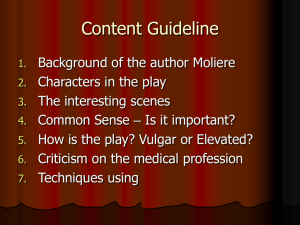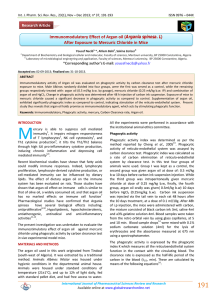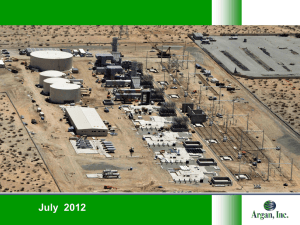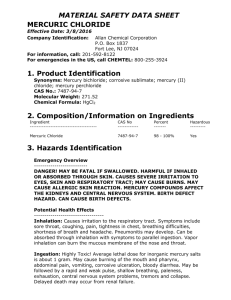Document 13309340
advertisement
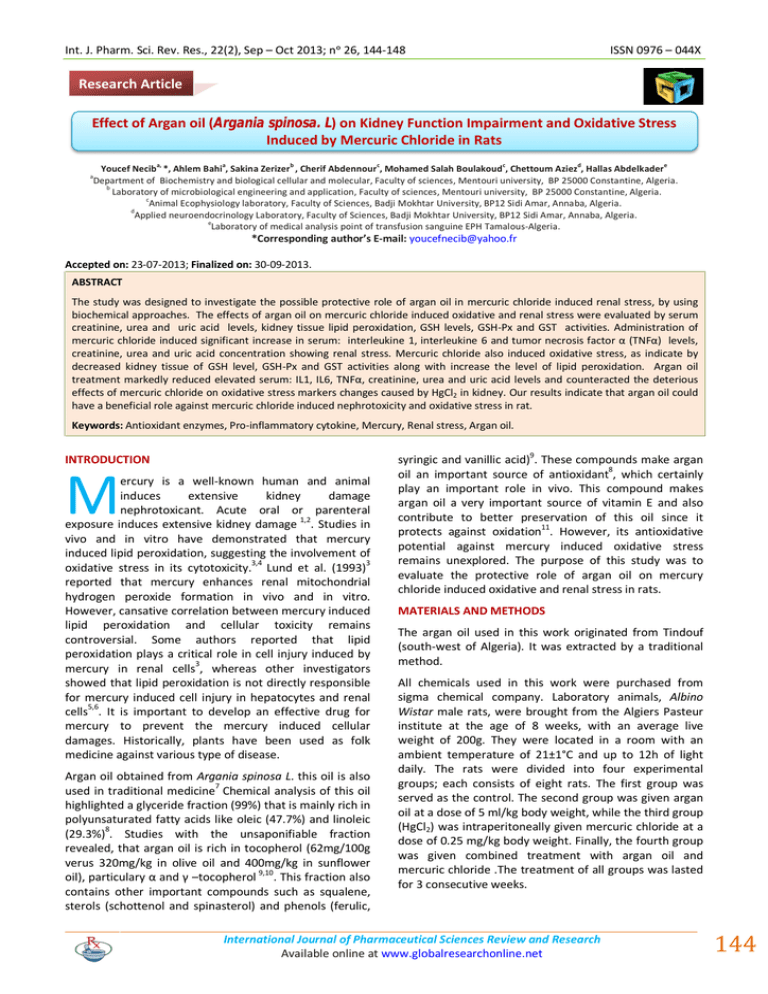
Int. J. Pharm. Sci. Rev. Res., 22(2), Sep – Oct 2013; nᵒ 26, 144-148 ISSN 0976 – 044X Research Article Effect of Argan oil (Argania spinosa. L) on Kidney Function Impairment and Oxidative Stress Induced by Mercuric Chloride in Rats a, a b c c d e Youcef Necib *, Ahlem Bahi , Sakina Zerizer , Cherif Abdennour , Mohamed Salah Boulakoud , Chettoum Aziez , Hallas Abdelkader Department of Biochemistry and biological cellular and molecular, Faculty of sciences, Mentouri university, BP 25000 Constantine, Algeria. b Laboratory of microbiological engineering and application, Faculty of sciences, Mentouri university, BP 25000 Constantine, Algeria. c Animal Ecophysiology laboratory, Faculty of Sciences, Badji Mokhtar University, BP12 Sidi Amar, Annaba, Algeria. d Applied neuroendocrinology Laboratory, Faculty of Sciences, Badji Mokhtar University, BP12 Sidi Amar, Annaba, Algeria. e Laboratory of medical analysis point of transfusion sanguine EPH Tamalous-Algeria. a *Corresponding author’s E-mail: youcefnecib@yahoo.fr Accepted on: 23-07-2013; Finalized on: 30-09-2013. ABSTRACT The study was designed to investigate the possible protective role of argan oil in mercuric chloride induced renal stress, by using biochemical approaches. The effects of argan oil on mercuric chloride induced oxidative and renal stress were evaluated by serum creatinine, urea and uric acid levels, kidney tissue lipid peroxidation, GSH levels, GSH-Px and GST activities. Administration of mercuric chloride induced significant increase in serum: interleukine 1, interleukine 6 and tumor necrosis factor α (TNFα) levels, creatinine, urea and uric acid concentration showing renal stress. Mercuric chloride also induced oxidative stress, as indicate by decreased kidney tissue of GSH level, GSH-Px and GST activities along with increase the level of lipid peroxidation. Argan oil treatment markedly reduced elevated serum: IL1, IL6, TNFα, creatinine, urea and uric acid levels and counteracted the deterious effects of mercuric chloride on oxidative stress markers changes caused by HgCl2 in kidney. Our results indicate that argan oil could have a beneficial role against mercuric chloride induced nephrotoxicity and oxidative stress in rat. Keywords: Antioxidant enzymes, Pro-inflammatory cytokine, Mercury, Renal stress, Argan oil. INTRODUCTION M ercury is a well-known human and animal induces extensive kidney damage nephrotoxicant. Acute oral or parenteral exposure induces extensive kidney damage 1,2. Studies in vivo and in vitro have demonstrated that mercury induced lipid peroxidation, suggesting the involvement of oxidative stress in its cytotoxicity.3,4 Lund et al. (1993)3 reported that mercury enhances renal mitochondrial hydrogen peroxide formation in vivo and in vitro. However, cansative correlation between mercury induced lipid peroxidation and cellular toxicity remains controversial. Some authors reported that lipid peroxidation plays a critical role in cell injury induced by mercury in renal cells3, whereas other investigators showed that lipid peroxidation is not directly responsible for mercury induced cell injury in hepatocytes and renal cells5,6. It is important to develop an effective drug for mercury to prevent the mercury induced cellular damages. Historically, plants have been used as folk medicine against various type of disease. Argan oil obtained from Argania spinosa L. this oil is also used in traditional medicine7 Chemical analysis of this oil highlighted a glyceride fraction (99%) that is mainly rich in polyunsaturated fatty acids like oleic (47.7%) and linoleic (29.3%)8. Studies with the unsaponifiable fraction revealed, that argan oil is rich in tocopherol (62mg/100g verus 320mg/kg in olive oil and 400mg/kg in sunflower oil), particulary α and γ –tocopherol 9,10. This fraction also contains other important compounds such as squalene, sterols (schottenol and spinasterol) and phenols (ferulic, syringic and vanillic acid)9. These compounds make argan oil an important source of antioxidant8, which certainly play an important role in vivo. This compound makes argan oil a very important source of vitamin E and also contribute to better preservation of this oil since it protects against oxidation11. However, its antioxidative potential against mercury induced oxidative stress remains unexplored. The purpose of this study was to evaluate the protective role of argan oil on mercury chloride induced oxidative and renal stress in rats. MATERIALS AND METHODS The argan oil used in this work originated from Tindouf (south-west of Algeria). It was extracted by a traditional method. All chemicals used in this work were purchased from sigma chemical company. Laboratory animals, Albino Wistar male rats, were brought from the Algiers Pasteur institute at the age of 8 weeks, with an average live weight of 200g. They were located in a room with an ambient temperature of 21±1°C and up to 12h of light daily. The rats were divided into four experimental groups; each consists of eight rats. The first group was served as the control. The second group was given argan oil at a dose of 5 ml/kg body weight, while the third group (HgCl2) was intraperitoneally given mercuric chloride at a dose of 0.25 mg/kg body weight. Finally, the fourth group was given combined treatment with argan oil and mercuric chloride .The treatment of all groups was lasted for 3 consecutive weeks. International Journal of Pharmaceutical Sciences Review and Research Available online at www.globalresearchonline.net 144 Int. J. Pharm. Sci. Rev. Res., 22(2), Sep – Oct 2013; nᵒ 26, 144-148 ISSN 0976 – 044X Twenty four hours after the last administration the blood was collected by retro- orbital sinus punction from each anesthetized rats. After centrifugation at 3000 rpm for 10min, the serum was separated immediately and stored at ̶ 20°c until determination of: IL1, IL6, TNFα, urea, creatinine and uric acid. Subsequently, rats were decapitated and kidneys were removed. Determination of Biochemical parameters Tissue preparation The data were subjected to student t test for comparison between groups. The values are expressed as mean ± SEM. Significance level was set at P<0.05, P<0.01, P<0.001. About 500mg of kidney was homogenized in 4mlof buffer solution of phosphate buffered saline (w/v: 500mg tissue with 4ml PBS, PH 7.4) homogenates were centrifuged at 10.000xg for 15min at 4°c. And the resultant supernatant was used for determination of: reduced glutathione (GSH) according the method of Weeckbekeretcory (1988)12, Thiobarbituric acid- reactive substance (TBARS) level by 13 method of Buege and Aust (1978) , and glutathione peroxidase (GSH-PX) and glutathione –S-transferase (GST) activities were measured by the method Flohe and Gunzler(1984)14 and Habig et al (1974)15 respectively. However, protein content was measured by the method of Bradford (1976)16. Serum urea, creatinine and uric acid were determined using commercial kits (Spinreact) and serum IL1, IL6,TNFα levels were assayed using specific Elisa kits for each cytokine (Boster, immunoleader). Statistical analysis RESULTS Effects of treatment on serum biochemical parameters A highly significant (P≤0.001) elevation in serum IL1, IL6, TNFα, urea, creatinine and uric acid levels was observed in mercuric chloride intoxicated rats. Only argan oil treatment did not show any significant alteration. However, the combined treatment of argan oil with mercuric chloride show a highly significant decline in serum IL1, IL6, TNFα, urea, creatinine and uric acid levels was noticed respect to controls (table 1). Table 1: Changes in biochemical parameters of control and rats treated with argan oil, mercuric chloride, and combined treatment of mercuric chloride with argan oil after 3 weeks of treatment. Parameters Treatment groups Control Argan oil HgCl2 Argan oil + HgCl2 Urea (g/l) 0.47±0.06 0.46±0.06 0.89±0.03*** 0.5±0.04*** Creatinine (mg/l) 2.68±1.02 2.6±0.7 7.13±1.72 *** 4.57±1.50 Uric acid (mg/l) 21.67±4.1 23.9±4.6 45.7±2.2*** 30.4±3.03*** IL1 (pg/ml) 0.101± 0.01 0.105± 0.01 0.692± 0.03*** 0.264 ± 0.03 IL6 (pg/ml) 0.114± 0.09 0.116± 0.06 0.301 ± 0.18*** 0.172 ± 0.09 TNFα (pg/ml) 0.125± 0.01 0.150± 0.01 0.472± 0.26*** 0.254± 0.08 Values are given as mean ± SEM for group of 8 animals each. *P≤0.05, compared to controls. **P≤0.01, compared to controls. ***P≤0.001, compared to controls. Effects of treatments on renal oxidative stress parameters Mercuric chloride exposure a significant depleted in reduced glutathione level, GSH-Px and GST activities. And a highly significant increase in kidney lipid peroxidation level in mercury intoxicated rats was noticed. Argan oil alone treatment did not show any significant decline. In combined treatment of mercuric chloride with argan oil, a highly significant increase in reduced glutathione level, GSH-Px and GST activities. And a significant depletion in lipid peroxidation level was recorded with respect to the control (Fig.1 and 2). DISCUSSION In the present study, oxidative stress induced by HgCl2 was evidenced in kidney of rats by increase in lipid peroxidation level and the stimulation of GSH-Px, GST and catalase activities. Accordingly, oxidative stress induced by HgCl2 has been previously reported3,17,18. As a consequence of lipid peroxidation biological membranes are affected causing cellular damage. In the present study, serum urea, creatinine, uric acid levels were significantly increased after 3weeks mercuric chloride (0.25mg/kg), showing insufficiency of renal function. Studies in animals have established that tubular injury plays a central role in the reduction of glomerular filtration rate in acute tubular necrosis. Two major tubular abnormalities could be involved in the decrease in glomerular function in mercuric chloride treated rats: obstruction and backleak of glomerular filtrate18. The alterations in glomerular function in mercuric chloride treated rats may also be secondary to ROS (reactive oxygen species), which induce mesangial cells contraction, altering the filtration surface area and modifying the ultrafiltration coefficient factors that 19,20 decrease the glomerular filtration rat . Elevated serum level of the cytokine IL1, IL6 and TNFα demonstrated the severity of Hg induced system inflammatory response. Argan oil as an antioxidant agent, ameliorated oxidative injury in the tissues and functional deteriorated. Both International Journal of Pharmaceutical Sciences Review and Research Available online at www.globalresearchonline.net 145 Int. J. Pharm. Sci. Rev. Res., 22(2), Sep – Oct 2013; nᵒ 26, 144-148 clical event is perceived by tissue macrophages and monocytes, which in turn secrete cytokines such as interleukine1, interleukine 6 and TNFα21, indicating the role of this cytokine in this toxicity, while argan oil depressed the IL1, IL6 and TNFα levels response. Figure 1: Reduced glutathione (nmol/ mg protein) and TBARS (nmol MDA /mg protein) levels in kidney of control and rats treated with argan oil, mercuric chloride, and combined treatment of mercuric chloride with argan oil after 3 weeks of treatment. ISSN 0976 – 044X oxidation of lipids or other molecules by inhibiting the initiation or propagation of oxidative chain reaction22 .The protective effect of argan oil is probably due to its high contents of powerful antioxidants, particularly: polyunsaturated and unsaturated fatty acid, polyphenols, tocopherols, sterols and ẞ -carotene, which are know as powerful antioxidants23. Figure 2: Enzyme activities of GPx (µmol GSH/ mg protein) and GST (nmol /min/mg protein) in kidney of control and rats treated with argan oil, mercuric chloride, and combined treatment of mercuric chloride with argan oil after 3weeks of treatment. Values are given as mean ± SEM for group of 8 animals each significant difference: *compared to controls (*P≤0.05; **P≤0.01; ***P≤0.001). Thus, it seems likely that the alleviation of Hg induced oxidative tissue damage by argan oil involves the suppression of a variety of pro-inflammatory mediators produced by leukocytes and macrophages. The activities of GSH-Px and GST that can clear to protect the cells from being injured represents the competence of clearing free radicals from the organism. MDA content manifests the level of lipid peroxidation, and then indirectly represents the level of damage of the cell of renal mitochondria. Evaluating from GSH, MDA levels and GSHPx, GST activities in kidney of rats. Hg alone significantly decreased GSH level, GSH-Px and GST activities and increased MDA content along with histological damage in kidney. Co-administration of argan oil and Hg significantly increased GSH level, and activities of GSH-Px, and GST and decreased MDA content. Some of the active constituents of argan oil have been reported to possess strong antioxidant activity and provokes free radical scavenging enzyme system. Antioxidants are compounds that can delay or inhibit Values are given as mean ± SEM for group of 8 animals each significant difference: * compared to controls (*P≤0.05; **P≤0.01; ***P≤0.001). This products act by several mechanism: scavenging of peroxy radicals, which break the peroxidation chain reaction, chelating free cu+2 to form redox-inactive completes and thus reducing metal-catalyzed oxidation of +2 lipid and inhibiting the binding of cu to apolipoproteins and subsequently preventing the modification of amino 24,25 acid-Apo-B protein residue . polyunsaturated and unsaturated fatty acid have protective effects against oxidative stress induced by mercuric chloride in rats, which are explained by their double bounds, that is difficult to oxidize and that involved in the fluidity of lipoproteins26. The antioxidant activity of polyphenolics is principally defined by the presence of orthodihydroxy substituents, which stabilize radicals and chelate. The antioxidant effect of phenolic acids and their esters depends on the number of hydroxyl group in the molecule. Argan oil, with comparison to olive oil, contains a higher quantity of ferulic acid (3470±13 versus 51±2 µg/kg of oil, respectively)27. This acid is more effective International Journal of Pharmaceutical Sciences Review and Research Available online at www.globalresearchonline.net 146 Int. J. Pharm. Sci. Rev. Res., 22(2), Sep – Oct 2013; nᵒ 26, 144-148 than ascorbic acid and other phenolic acid such as pcoumaric acid, since the electron donating methoxy group allows increased stabilization of the resulting aryloxyl radical through electron delocalization after hydrogen 28 donation by the hydroxyl group . This showed that, the direct inhibition of trans-conjugated dienehydroperoxyde isomer formation is related to the H-donating ability of the phenol29. Argan oil, but not olive or sunflower oil, also contains another important phenolic acid: syringic acid (68±4µg/kg), this antioxidant compound protects against lipid peroxidation 30. ẞ-carotene of argan oil may reduce cell damage, especially the damage to DNA molecules, thus playing the role in the repair of regeneration process of damaged liver cells. ẞ -carotene of argan oil may scavenger free radicals generated by mercuric chloride and reduces the lipid peroxidation. The antioxidant mechanism of ẞ carotene has been suggested to be singlet oxygen quenching, free radical scavenging and chain breaking during lipid peroxidation 31,32. Vitamin E, function as a trap for lipid peroxyl (LOO) and other radicals, effectively inhibiting the peroxidation of cellular membranes. Vitamin E prevents lipid peroxidation and maintains GSH and ascorbic acid levels in damaged tissue by inhibiting free radical formation. According to Roe and Sharma (2001)33, vitamin E showed protective effect against HgCl2 may be due to impaired absorption of mercury in the gastrointestinal tract. Ran et al (1996)34 postulated that, vitamin E has a protective effect against mercury toxicity. Vitamin E inhibits oxidative damage caused by mercury and cadmium intoxication35. Saponin content of argan oil significantly inhibited peroxyl radical induced lipid peroxidation in rat kidney. CONCLUSION It may be concluded that combined treatment of argan oil has a preventive and protective effect on mercuric chloride induced oxidative stress. More-over, it protects from HgCl2 induced renal dysfunction and executes its modulatory role in mercury induced free radical production. ISSN 0976 – 044X 5. Paller MS. Free radical scavengers in mercuric chlorideinduced acute renal failure in the rat. Journal of laboratory Clinical and Medical. 105, 1985, 459-463. 6. Strubell O, Kremer J, Tilse A, Keogh J, Pentz R. Comparative studies on the toxiciry of mercury, cadmium, and copper toward the isolated perfused rat liver. Journal of Toxicology and Environmental Health. 47, 1996, 267-283. 7. Boukhobza M, Pichon P. L’arganier, resource économique et médicinale pour le maroc. Phytotherapia. 27, 1988, 21-26. 8. Chimi H, Gillard J, Collard P. autoxydation de l’huile d’argan (arganiaspinosa) sapotacée du maroc. Science Alimentaire. 14, 1994, 117-241. 9. Khallouki F, Younos C, Soulimani R, et al. cosumption of argan oil (moroco) with its unique profile of fatty, tocopherols, squalene, sterols and phenolic compounds should confer valuable cancer chemopreventive effects. Eurpeen Journal of cancer prevention. 12, 2003, 67-75. 10. Aguilera C M, Mesa M D, Ramirez-Tortosa, M C, et al. sunflower oil does not protect against LDL oxidation as virgin olive oil does in patients with peripheral vascular disease. Clinical Nutrition. 23, 2004, 673-81. 11. Chimi H, Rahmani M, Cillard J, Gillard P. Etude de la fraction phénolique des huiles d’olives vierges et d’argan du Maroc. Actes instititu of Agricol and Vétérinaire. 8, 1988, 17-22. 12. Weckbercker G, Cory JG. ribonucleotidereductase activity and growth of glutathione-depended mouse leukaemia L 1210 cells in vitro. Cancer letter. 40,1988, 257264. 13. Buege JA, Aust SD. Microsomal lipid peroxidation. Methods enzymol. 105, 1984, 302-10. 14. Flohe L, Gunzler WA. Analysis of glutathione peroxidase. Methods enzymol. 105, 1984, 114-21. 15. Habig WH, Pabst Jakoby WB. Glutathione-S-transferase the first step in mercapturic acid formation. Journal of Biology and Chemical. 249, 1974, 7130-9. 16. Bradford MA. Rapid and sensitive method for the quantities of microgram quantities of protein utilizing the principale of protein-dye binding. Anal Biochemical . 72, 1976, 248-54. REFERENCES 17. Sener G, Sehirli O, Tozan A, Velioglu-ovuç A, Gedik N, Omnrtag GZ. Gingobiloba extract protects against mercury (II)-induced oxidative tissue damage in rats. Food and chemical Toxicology. 45, 2007, 543-550. 1. Fowler BA, Woods JS. Ultrastructural and Biochemical changes in renal mitochondria during chronic oral methylmercury exposure: the relationship to renal function. Experimental Molecular and pathological. 27, 1977, 403-412. 18. Necib Y, Bahi A, Zerizer S. Protective role of sodium selenite on mercuric chloride induced oxidative and renal stress in rats. Journal of stress physiology and biochemistry. 9, 2013, 159-172. 2. Goyer RA, Rhune BC. Toxic changes in mitochondrial membranes and mitochondrial function. In: Trump, B.F., Arstilla, A.U. (Eds.), Pathobiological Cell and Membrane. Academic Press, 1975, New York. 19. Stohs SJ, Bagchi D. Oxidative mechanisms in the toxicity of metal-ions. Free Radicical Biology Medical. 18, 1995, 321336. 3. Lund BO, Miller DM, Woods JS. Mercury-induced H2O2 production and lipid peroxidation in vitro in rat kidney mitochondria. Biochemical and Pharmacology. 42, 1991, :S181-S187. 4. Stacey NH, Kappus H. Cellular Toxicity and lipid peroxidation in response to mercury. Toxicology and Applied pharmacology. 63, 1982, 29-35. 20. Zalups PK. Molecular interactions with mercury in the kidney. Pharmacology Review. 52, 2000, 113-143. 21. Ziembia SE, McCabe Jr, Rosenspire AJ. Inorganic mercury dissociates preassembled Fas/CD95 receptor oligomers in T lymphocytes. Toxicology Applied Pharmacology. 206, 2005, 334-342. International Journal of Pharmaceutical Sciences Review and Research Available online at www.globalresearchonline.net 147 Int. J. Pharm. Sci. Rev. Res., 22(2), Sep – Oct 2013; nᵒ 26, 144-148 ISSN 0976 – 044X 22. Velioglu YS, Mazza G, Gao L, Oomah B D. Antioxidant activity and total phenolies in selected fruits, vegetables and grain products. Journal of Agricol and food chemical. 46, 1998, 4113-4117. 29. Cheng J P, Hu W X, Lin X J M, Shi w, Wang W.H. Expression of C-fos and oxidative stress on brain of rats reared on food from mercury-selenium coexisting mining area. Journal of Environment and Sciences (china). 18(4), 2006, 788- 792. 23. Masella R, Giovannini C, Vari R, Di benedetto R, Coni E, Volpe R. Effect of dietary virgin olive oil phenols on low density lipoprotein oxidation in hyperlipidemic patients. Lipids. 36, 2002, 1195-202. 30. Krinsky N I, Deneke S M. Interaction of oxygen and oxyradicals with carotenoids. Journal of nation cancer institu. 69, 1982, 205-210. 24. Fuhram B, Lavy A, Aviram M. consumtion of red wine with meals reduces the susceptibility of human plasma and LDL to lipid peroxidation. American Journal of clinical nutrition. 61, 1995, 5549-54. 25. Jialal I, Fuller C J, Huet B A. The effect of a-tocopherol supplementation on LDL oxidation a dose ereponse study. Arterioscler Thrombosis and Vascular Biology. 15, 1995, 1908. 26. Sola R, Motta C, Maille M. Dietary monounsaturated fatty acids enhance cholesterol efflux from human fibroblasts, relation to fluidity, phospholipid fatty acid composition, overall composition, and size of HDL3. Arterioscler thrombosis. 13, 1993, 958-66. 27. Kweon M H, Hwang H J, Sung H C. Identification and antioxidant activity of novel chlorogenic acid derivatives from bamboo (phyllostachysedulis). Journal of Agricol and Food Chemical. 49, 2001, 4646-55. 31. Gerster H. Anticarcinogenic effect of carotenoids.Inter. Journal of Vitamin and Research. 63, 1993, 93-121. common Nutrition 32. Garg M C, Chaudhary D P, Bansal D D. Effect of vitamin E supplementation on diabetes induced oxidative stress in experimental diabet in rats. Indian Journal of Experimental and Biology. 43, 2005, 177-180. 33. Rao M V, Sharma P S N. Protection effect of vitamin E against mercuric chloride reproductive toxicity in male mice. Reproduction Toxicology. 15(16), 2001, 705-712. 34. Rana S V S, Singh R, Verma S. Protective effects of few antioxidants on liver function in rats treated with cadmium and mercury. Indian Journal of Experimental Biology. 34, 1996, 177-179. 35. Patil G R , Rao M V. Rale of ascorbic acid on mercuric chloride toxicity in vital organs of moce. Indian Journal of Environmental toxicology. 9, 1999, 53-55. 28. Faraji H, Lindsay R C. Characterization of the antioxidant activity of sugars and polyhydric alcohols in fish oil emulsion. Journal of agricol and Food chemical. 52, 2004, 7164-71. Source of Support: Nil, Conflict of Interest: None. International Journal of Pharmaceutical Sciences Review and Research Available online at www.globalresearchonline.net 148
